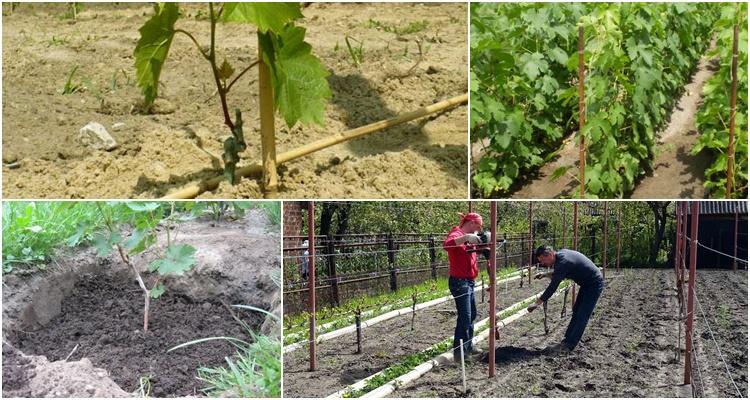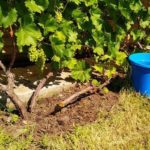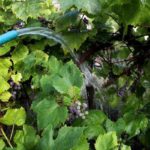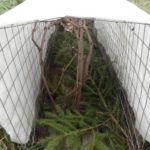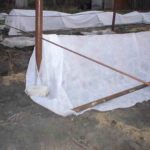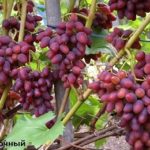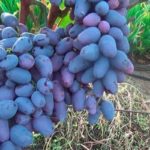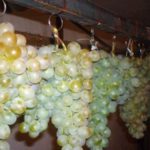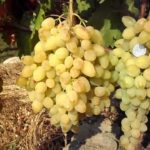People have been cultivating grapes since ancient times. The berry, soaked in the sun, was sung by poets, the heavy clusters inspired artists and appeared in the paintings of great masters. He has always been a symbol of sun, warmth and fun. Today the vine is grown in different regions. The abundance of early varieties made it possible to grow grapes not only in the southern regions. For example, the Rusven grape variety takes root well and bears fruit in the Middle Volga and even in the Moscow region.
Description and characteristics of Rusven grapes
This variety was bred through the joint efforts of breeders from Hungary and Russia. It belongs to very early pink table varieties. The ancestors of the variety are Muscat de Saint Vallier and R-66. The Rusven grape is distinguished by its growth and vigor of shoots. It tolerates even frosty winters well, and in regions with mild and temperate climates it can winter without shelter.
The clusters of Rusven are large; with an average weight of 300-350 grams, the clusters can reach a weight of 1 kilogram. They have a cylindrical or conical shape. The berries are pink, oval, weighing 50-55 grams and sugar content 20%. The skin of the berries is thin. They are suitable for wine production and fresh consumption. Consumers like the subtle, sage-nutmeg aftertaste.
This is a high-yielding variety with a ripening period of 110 days, regardless of the growing region. The vine quickly acclimatizes and begins to bear fruit in the second year after planting. The bunches are perfectly stored and do not lose their presentation during transportation.
Main advantages and disadvantages
Rusven has gained admirers among gardeners thanks to a lot of positive characteristics.
Wine from Rusven has a spicy aftertaste. The bunches are characterized by uniform ripening.
How to grow the variety correctly
The grapes are unpretentious, the vine takes root well in a new place, and early fruiting allows you to get the first harvest 2 years after planting.
Dates and place
For the vine, a place is chosen on a hillock, protected from the wind. Select a drained area with deep groundwater. You can place the grapes under the protection of a house or outbuildings, at a distance of at least 1 meter from the walls.
Propagated by cuttings, which are planted in the ground in spring or autumn. For northern regions, spring planting is preferable (in May), so that the vine has time to get stronger and grow before autumn.
Landing technology
It grows poorly in lowlands and wetlands. The highest yield is obtained on fertile lands; if the soil is rocky, it creates natural drainage for the vines. The grapes are sensitive to return frosts; in the middle zone and northern regions they require winter shelter.
A hole for the seedling is dug 1 meter deep and 60-65 centimeters in diameter. A drainage layer of large pebbles or broken bricks and crushed stone is laid at the bottom. Its thickness is 10-15 centimeters.
Next comes a soil mixture of fertile soil, crushed stone and sand in the ratio: 3:1:0.5. Fill the hole with fertile soil and gradually compact it. The cuttings are deepened so that 2-3 buds remain on the surface. A stake is driven in next to the hole to support the vine, and after 1.5 meters another stake is driven in to serve as a trellis. Rusven is a variety with a tall vine, the distance between seedlings is about 3 meters.
Rules for caring for crops
Caring for Rusven is no different from caring for other grape varieties. The bushes need feeding, the vines need to be pruned and protected from frost. It is protected from pests and diseases.
Watering and fertilizing
When planting, cuttings are fertilized with ash or dolomite flour, and complex mineral fertilizers are used as recommended by the manufacturer. The next time they are introduced is after 2 years.
An adult vine requires root and foliar (leaf) feeding. In the spring, after the snow melts, nitrogen fertilizers are applied, and before flowering, fertilize with complex fertilizer. Before the buds open, the grapes are sprayed with a mixture of copper and iron sulfate and boric acid.
The next foliar feeding is carried out when the berry reaches the size of a pea. Use a mixture of potassium permanganate, urea, iron sulfate or a ready-made fertilizer mixture. To increase sugar content, with medium-sized berries, add a potassium complex. After harvesting - phosphate and potassium fertilizer. Humus is added during autumn digging.
In the middle zone and northern regions, grapes are watered only in dry summers. Water it with warm water.
Trimming
No more than 40 eyes are left on one Rusven bush. Formative pruning is carried out in the fall, before covering the vine for the winter. The shoots are cut back to a mature vine. When several shoots grow from one place, the strongest one is left, the others are cut off. In the spring, damaged and diseased areas are removed.
Wintering grapes
For wintering, the vines are removed from the trellises, tied in bunches and placed in a prepared trench 20 centimeters deep next to the bushes. Cover with burlap and sprinkle with a 25-30 centimeter layer of earth. Or they simply lay the bunches on the ground, cover them with burlap, and on top with plastic film, and sprinkle the film with earth so that the shelter does not blow away with the wind.
Diseases and pests
Rusven is resistant to mildew and oidium (powdery mildew). It is protected from wasps by placing traps with sweet contents between the bushes, covering the bunches with gauze or placing them in fine mesh bags. You can coat the trellises with insecticide to kill the insects.
Cleaning and storage
The grapes are harvested in mid-August. The collection is carried out in dry sunny weather. There should be no dew on the grapes. They are carefully cut without touching the berries. It is convenient to store grapes in boxes with wood shavings at the bottom. The brushes are laid loosely so that they do not touch each other. Cover the top with shavings and store in a cellar or basement at a temperature of +2...+4 °C.
Gardeners speak highly of Rusven; high yields and winter hardiness make it possible to grow grapes in regions with not too long and warm summers.





